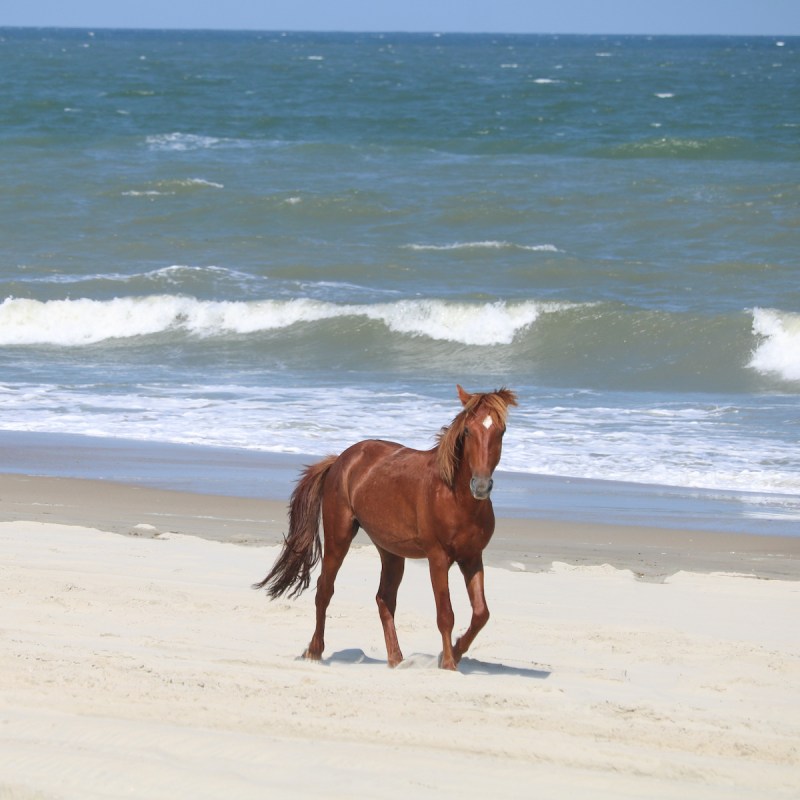
If you’re looking for an unforgettable adventure while on a North Carolina beach vacation, then you need to experience a wild horse tour! This unique and exhilarating activity will have you exploring the beaches and dunes of North Carolina’s northernmost coast while enjoying the company of some of nature’s most beautiful creatures. Keep reading to learn everything you need to know about this must-do experience!
Videos by TravelAwaits

Where To Find The Wild Horses Of North Carolina
You can find wild horses in the Currituck Sound Area and along the beaches near Corolla and Carova Beach. The horses roam over 7,544 acres, which they share with approximately 700 homes, thousands of vehicles, and even more humans.
There are other wild horse herds in Okakroke and farther south along the Crystal Coast of North Carolina.
How To Get There
Corolla is at the northern point of North Carolina’s Outer Banks. It is a remote but busy area that can be reached by a small plane, shallow-draft boat, or car via a curvy, two-lane highway. With the Atlantic Ocean on the east and the Currituck Sound on the west, the northern border serves as a gate to Virginia.
If you’re driving, once you reach Kitty Hawk, North Carolina, head north on Highway 12 through Duck into Currituck County. The road ends 10 miles before you reach Virginia. The entire Currituck Outer Banks is commonly referred to as Corolla.

The History Of The Wild Horses On The Beach Near Corolla
Wild horses in present-day Corolla carry the distinguishing features of Spanish-type horses. Like horses of Arabian ancestry, they have one less vertebra than most breeds. Their size, endurance, and temperament, along with their unbridled beauty, indicate they are remnants of Spanish stock.
The famous Corolla Wild Horses are thought to be descendants of a herd established by Spanish settlers in the 1500s. Some feel they came when settlers arrived and when their settlement failed, they left the area and the horses to fend for themselves.
Others believe that the horses were on-board a ship or several ships that wrecked off the coast, and they swam to shore and ran free along the sandy beaches.
There are also other theories, but these two are the most popular. The horses have roamed the upper Outer Banks for over 500 years, and while their population has dwindled, the herd is slowly growing again. Over the years, they have weathered many a storm, hurricane, and other mishaps, but they continue to call the Corolla area home.
The Best Way To See The Wild Mustangs Of North Carolina
There are several ways to see the wild mustangs of North Carolina, but the best is to take a guided tour. Guided tours offer visitors a glimpse of the Spanish Mustangs that have roamed the beaches of Currituck’s Outer Banks for years. It is the best way to get as close as possible to them. Eight different companies provide tours along the northern coast of North Carolina.
The tours take you on the beach in a four-wheel-drive vehicle made for sand travel. They can also take you to other places in the area where the horses often visit. Tour operators know where the horses usually congregate, and you have the best opportunity of seeing them when you book a tour. Tours run several times a day with each of the companies. Some companies run their tours year-round while others run them from May through September.

When Is The Best Time To See The Wild Spanish Horses Of North Carolina?
The mustangs are viewable throughout the year. The season or time of day does not seem to matter. They are not always on the beach but often on the sound. The weather usually determines where the horses will be hanging out.
What You Need To Know About The Wild Mustangs Of North Carolina
- While beautiful, the horses are “wild!” They are not domesticated or tamed. They are considered feral horses.
- Wild horses can kick and bite. The horses may seem friendly and docile, but they will always be unpredictable and potentially dangerous.
- For your safety and the safety of the horses, you should not get closer than 50 feet from the horses. It is illegal to be closer than 50 feet to the horses. Petting them is not an option.
- A horse’s line of vision extends from its nose around its side and as far back as its hip.
They have a 350-degree field of vision.
- They eat sea oats, acorns, coarse grasses, persimmons, and other native vegetation. They find water by digging in the sand to release the freshwater below. Wild horses cannot eat apples or carrots; feeding them these items can cause severe sickness and even death. It is illegal to feed wild horses.
- If you observe an injured or sick horse, do not touch or try to help it; please call the Corolla Wild Horse Fund.

How Are The Wild Horses Of North Carolina Protected?
The wild horses of Corolla are ancestors of the horses of kings and deserve to be protected.
There were once thousands of horses roaming wild, and now the Corolla and the Currituck Sound herd is down to approximately 107 horses.
In May 2010, the colonial Spanish mustang — the type of wild horse you’ll see in the Outer Banks — became the North Carolina State Horse.
Here are some more guidelines on keeping the wild horses safe and protected:
- It is illegal to be within 50 feet of a wild horse. View their unbridled beauty from a respectable distance. The wild horses sometimes wander along the beach when visitors are out and about. You are responsible for keeping a distance of at least 50 feet from the horses at all times, even when the wild horses approach you. Please do your best to move away from the horses without disturbing them. The horses head to the beach in the summer to get cooled off and get away from biting insects. Please respect their needs and provide space for them.
- It is also illegal to feed wild horses. Apples, carrots, and other such items can mean death to a wild horse. According to the Corolla Horse Fund, several horses have died from being fed by well-intentioned humans.
How Does The Corolla Horse Fund Care For The Wild Horses?
As the guardians of the wild herd, the Corolla Horse Fund responds 24 hours a day, 365 days a year for emergencies and other tasks involved with herd management.
Each wild horse is identified by home territories, color, and markings that are documented and entered into a database. They are not microchipped or branded. Aerial counts are conducted and compared to field studies.
If a wild horse becomes critically injured or is seriously ill, the fund may have to capture and permanently remove them from the wild. They also remove and raise orphaned foals.
A wild horse cannot be returned to the wild once rehabilitated because they have been exposed to domestic horses where they received care. They could carry a disease back to the wild herd if they returned. They also will get used to human handling and may approach humans if returned to the wild. The horses are often available for adoption.

How You Can Help The Wild Horses
- One of the best ways you can help is to view them responsibly. And if you see something is wrong or someone is hurting or harassing the wild horses, report it to the Corolla Wild Horse Fund.
- Make donations to the Corolla Wild Horse Fund.
- Shop their Museum Store.
- Attend the Corolla Wild Horse Fund events and educational programs.
- Consider adopting one of the rehabilitated wild horses.
If you want to see some of the most beautiful horses in North America, then a trip to the Outer Banks should be on your travel list. The Wild Horse Tour will take you through areas where these majestic creatures roam free. You’ll learn about their history and how they are protected while getting as close as possible to look at these stunning animals. Plan your visit today, and if you want to help protect them, consider donating or adopting one of these majestic creatures.
Related Reading:
